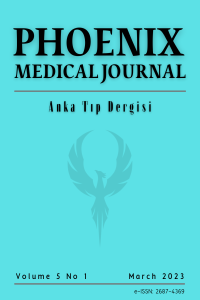Açık Radikal Sistektomi Sonrası Eviserasyona Etki Eden Faktörler
mesane kanseri, komplikasyon, eviserasyon, radikal sistektomi
Factors Affecting Evisceration Following Open Radical Cystectomy
bladder cancer, complication, evisceration, radical cystectomy,
___
- Ziegelmueller BK, Jokisch JF, Buchner A, Grimm T, Kretschmer A, Schulz GB, et al. Long-Term Follow-Up and Oncological Outcome of Patients Undergoing Radical Cystectomy for Bladder Cancer following an Enhanced Recovery after Surgery (ERAS) Protocol: Results of a Large Randomized, Prospective, Single-Center Study. Urol Int. 2020;104:55-61.
- Khan MS, Challacombe B, Elhage O, Rimington P, Coker B, Murphy D, et al. A dual-centre, cohort comparison of open, laparoscopic and robotic-assisted radical cystectomy. Int J Clin Pract. 2012:66:656-662.
- Zattoni F, Palumbo V, Giannarini G, Crestani A, Kungulli A, Novara G, et al. Perioperative Outcomes and Early Survival in Octogenarians Who Underwent Radical Cystectomy for Bladder Cancer. Urol Int. 2018;100:13-17.
- Schiavina R, Borghesi M, Guidi M, Vagnoni V, Zukerman Z, Pultrone C, et al. Perioperative complications and mortality after radical cystectomy when using a standardized reporting methodology. Clin Genitourin Cancer. 2013;11:189-197.
- Cantiello F, Cicione A, Autorino R, De Nunzio C, Salonia A, Briganti A, et al. Metabolic syndrome, obesity, and radical cystectomy complications: a clavien classification system-based analysis. Clin Genitourin Cancer. 2014;12:384-393.
- Greenhalgh David G. Wound healing and diabetes mellitus. Clinics in Plastic Surgery. 2003;30: 37-45.
- Mahey R, Ghetla S, Rajpurohit J, Desai D, Suryawanshi S. A prospective study of risk factors for abdominal wound dehiscence. International Surgery Journal. 2016;4:24-28.
- Pavlidis TE, Galatianos IN, Papaziogas BT, Lazaridis CN, Atmatzidis KS, Makris JG, et al. Complete dehiscence of the abdominal wound and incriminating factors. Eur J Surg. 2001;167:351-354.
- Spiliotis J, Tsiveriotis K, Datsis AD, Vaxevanidou A, Zacharis G, Giafis K, et al. Wound dehiscence: is still a problem in the 21th century: a retrospective study. World J Emerg Surg. 2009:3;4-12.
- Riou JP, Cohen JR, Johnson H Jr. Factors influencing wound dehiscence. Am J Surg. 1992;163(3):324-330.
- Kenig J, Richter P, Lasek A, Zbierska K, Zurawska S. The efficacy of risk scores for predicting abdominal wound dehiscence: a case-controlled validation study. BMC Surg. 2014:14;65-72.
- Buchs NC, Gervaz P, Secic M, Bucher P, Mugnier-Konrad B, Morel P. Incidence, consequences, and risk factors for anastomotic dehiscence after colorectal surgery: a prospective monocentric study. Int J Colorectal Dis. 2008;23:265-270.
- Alves A, Panis Y, Trancart D, Regimbeau JM, Pocard M, Valleur P. Factors associated with clinically significant anastomotic leakage after large bowel resection: multivariate analysis of 707 patients. World J Surg. 2002;26:499-502.
- Yayın Aralığı: Yılda 3 Sayı
- Başlangıç: 2019
- Yayıncı: İbrahim İKİZCELİ
Otizm Spektrum Bozukluğu: Birinci Basamakta Neden Az Tanı Almaktadır?
Açık Radikal Sistektomi Sonrası Eviserasyona Etki Eden Faktörler
Cem KEZER, Mehmet Fatih AKBULUT, Ömer SARILAR, Ufuk ÇAĞLAR, Mücahit GELMİŞ, Faruk ÖZGÖR
Acil Serviste Delici Çivi Yaralanmaları
Ramipril İlişkili Yanan Ağız Sendromu: Vaka Sunumu
Erkut ETÇİOĞLU, Muhammet Raşit AYDIN, Yasin CANBOLAT
Yoğun Bakımda Ateşin Yönetilmesi
Dev Travmatik Parafalsin Subdural Hematom
Serdar ÖZDEMİR, İbrahim ALTUNOK
Pandemide Artan Akut Ekstremite İskemisinin Farkında mıyız?
Fazıl AVCI, Gürkan KIRAN, Hakan KIRAN, Salih SERİN
Kist Hidatik Hastalığınının İntratorasik ve Pulmoner Tutulumları
Servan VURUCU, Cihan YÜKSEL, Anıl AKÇA, Taylan ÖNDER, Safiye Bilge GÜÇLÜ KAYTA, Sevil ALKAN
Üniversite Acil Servisine 112 Ambulans ile Başvuran Hastaların Uygunluk Düzeyinin Değerlendirilmesi
